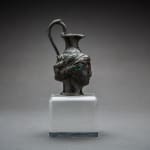Hellenistic Period Miniature Bonze Toiletry Vessel Shaped as a Female Head, 300 BCE - 100 BCE
Bronze
height 9.8 cm
height 3 7/8 in
height 3 7/8 in
FF.062
This vase was probably used to contain ointments or perfumed oils and although it's creation is inspired by Greek Hellenistic prototypes, its craftsmanship is typically Etruscan. It was made in...
This vase was probably used to contain ointments or perfumed oils and although it's creation is inspired by Greek Hellenistic prototypes, its craftsmanship is typically Etruscan. It was made in the 3rd century BC, probably in a workshop in Orvieto or Vulci, known at the time for their refined bronze products. Made with the lost-wax casting method, this small bronze container is fashioned in the form of a woman's head. The delicately modeled face, pensive and gentle, is meticulously engraved with a burin, while her hair is gently held back in a typically Classical style. There is a tall and thin handle at the back to facilitate pouring the liquid.
The craftsmanship of the vase is typically Etruscan, but its form is borrowed from certain Hellenistic period vessels: bronze cast perfume vases and oinochoes (wine jugs), of similar dimensions and also shaped like a woman's head, that were made in Greece in the late 4th and early 3rd centuries BC.
The craftsmanship of the vase is typically Etruscan, but its form is borrowed from certain Hellenistic period vessels: bronze cast perfume vases and oinochoes (wine jugs), of similar dimensions and also shaped like a woman's head, that were made in Greece in the late 4th and early 3rd centuries BC.



